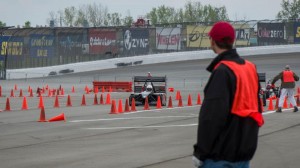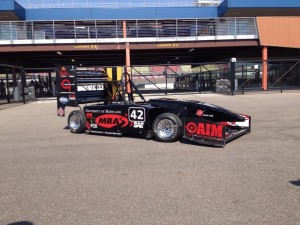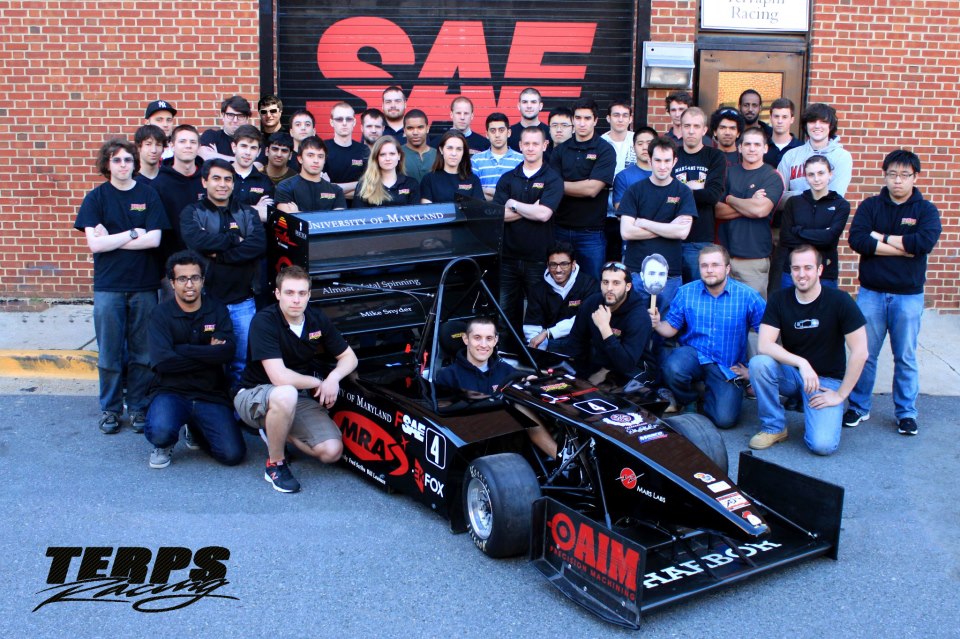Editor’s Note: This is Part 4 of our Campus Pit Stop series of articles highlighting automotive engineering work being done on campuses across America. The series covers some of the schools’ participation in the Formula SAE and Baja SAE programs. For more information on these programs, please see our Campus Pit Stop introduction post.
In the corporate world, it ultimately takes a cohesive team to succeed.
It also takes hard work, persistence, and the ability to adapt.
Although the Formula SAE program is a competition between hundreds of universities, the program was ultimately conceived to help mechanical engineering students develop those successful qualities. As Terps Racing—the University of Maryland FSAE team—found out in 2013, some of the best lessons are the hardest ones.
After a tough 2012 season in which the Terps Racing “TR12” race car barely passed tech, missed most of the dynamic events, and only completed four laps in the endurance competition at the FSAE Michigan event, the team saw huge improvements in 2013.
They finished a respectable 30th overall (out of 120 teams) at the same event in 2013 thanks to several improvements:
- A CFD-modeled aerodynamic design with unique bi-plane wings that helped the team earn a Top 10 finish in design. The aerodynamics on the 2013 Terps Racing vehicle, “TR13,” combines an effective undertray, large diffuser tunnels, and large wings with a relatively flat over-body to generate as much downforce as possible.
- A new steel frame, which replaced a rear carbon fiber monocoque with almost no additional weight. The frame was specially designed to work with the aerodynamics package and includes a narrowed rear section.
- A light and fuel-efficient single-cylinder engine that earned a Top 20 finish in fuel efficiency. The Honda CRF450X one-cylinder engine weighs considerably less than four-cylinder option allowed by Formula SAE.
- A redesigned steering system that helped yield a Top 20 finish on the autocross.
The Terps Racing car was actually on its way to an incredible Top 10 finish–an amazing turnaround from the year before–when a heartbreaking, last-minute engine failure occured on lap 23 of the 24-lap endurance competition.
Now the team is working to ensure the lessons learned from last year’s heartbreak lead to an even higher finish in 2014.
Lesson #1: Testing, Testing, Testing
 To be clear, the Terps Racing team knew the importance of testing before last year’s FSAE competition in Michigan. It was testing that led the team to swap out its original carbon fiber rear monocoque with a steel frame.
To be clear, the Terps Racing team knew the importance of testing before last year’s FSAE competition in Michigan. It was testing that led the team to swap out its original carbon fiber rear monocoque with a steel frame.
“In the fall, we designed and created a rear monocoque out of carbon fiber to house our engine,” said Team Manager Emily Posey. “In December, it completely failed during testing, and we decided to switch to a steel frame, last-minute. Because we changed our design so late in the year, a lot of other things were pushed back significantly.”
Although the steel frame performed well at the FSAE, the engine failure near the very end of the competition reinforced the importance of testing and tuning.
“We initially thought the failure was mainly due to running the engine at high loads for an extended period of time–something that is not typical for a dirt bike engine,” said Carl Gunter, Chief Engineer of Terps Racing. “Later on, we discovered there was an issue with the oil cooler we ran at the competition. We placed the oil cooler above the crankcase, but there was no check valve in place to keep the oil from draining back into the crankcase. So when the engine was running, the oil level was too low.”
Gunter believes the oil cooler position, along with the high lateral G-forces created during competition, created an oil strarvation issue that contributed to the engine failure.
“The most important lesson we took away from last year’s experience is that testing is key,” Posey said. “The more testing a team does before the actual competition, the more likely they will do well in the dynamic events. You have to break things while you are at home so things won’t break during the big moment.”
Lesson #2: Business Matters
While a lot of teams put the majority of their focus on the dynamic events (acceleration, skid pad, autocross, etc.), Posey said the team has a new appreciation for the static events—an area where the team has struggled in the past.
“The are lots of points in static events (design presentation, business sales, cost report), and these points become crucial when it gets down to the wire,” she said. “It’s relatively easy to build a car, but it’s a whole different story to build a well-engineered car whose design you can justify to professionals in the field. It often comes down to a few points here and there, and by dominating static events, a team can set themselves up for a win before they even take the car on the track.”
According to Posey, the 2013-14 Terps Racing team will have an increased focus on the business presentation side of the competition to go along with its build plans.
Lesson #3: Communication is Key
 The Terps Racing team consists of about 55 people, and there is a constant in-flux of new members from year-to-year.
The Terps Racing team consists of about 55 people, and there is a constant in-flux of new members from year-to-year.
“Because Formula SAE is a school competition, students graduate and go into the workforce,” Posey said. “Strong teams must have the ability to efficiently and effectively pass down information to the next generation of leaders. We’ve had some issues with documentation in the past, especially during crunch time toward the end of the season, and we now realize how paramount it really is. Our team needs to get better at thoroughly understanding how and why every part on the car was designed and built.”
The Terps Racing team is comprised of five subgroups: chassis, steering/suspension, engine/powertrain, electronics/instrumentation, and aero/composites. For the fall semester, Terps Racing began using weekly blog posts to improve communication among team members.
“The main obstacles that come with such a large group are communication and delegation of tasks,” Posey said. “Everyone can scroll through the blog posts and see what each subteam is up to, and if anyone needs an extra hand with their projects.”
Goals for 2014 Formula SAE competition include:
- Addressing potential reliability issues with the engine
- Redesigning and optimizing the steel frame
- Continuing the long-term development of a carbon fiber monocoque for future years
- Improving the team’s business presentation and design and cost reports
Although mechanical engineering know-how and hands-on work are the main keys to success in the FSAE program, Terps Racing knows testing, attention to detail, and good communication are essential to success in 2014—and way beyond.
“FSAE prepares us for the world after college by giving a group of engineers a problem and allowing us to solve the problem the way we want to approach it,” Posey said. “We must work cohesively as a group in order to succeed, just as a company or team of engineers must work together to design and manufacture a product in the corporate world.”


Comments